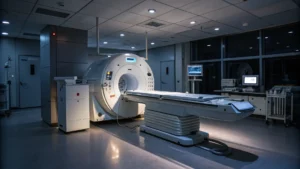Sajeev Thomas Ph.D, OncoRace, Dubai, United Arab Emirates
Radiation in medicine, especially in fields like radiation oncology and radiosurgery, stands apart from many other clinical specialties due to its intricate blend of clinical and technical components. While the public often believes that selecting the right clinician is the sole determinant of successful treatment, the reality is far more complex. Effective radiation therapy hinges on a synergistic partnership between clinical expertise and technical precision, making medical physicists indispensable members of the healthcare team. This document explores the multifaceted roles of radiation oncologists and medical physicists, highlighting their interdependent responsibilities and the technological advancements that continue to shape this dynamic field.
The Clinical Component: The Role of Radiation Oncologists
Radiation oncologists are medical doctors who specialize in using radiation to treat cancer. Their responsibilities encompass a wide range of clinical activities, starting with the selection and diagnosis of appropriate patients for radiation therapy. This process involves utilizing various imaging modalities, such as CT, MRI, and PET scans, to accurately delineate the tumor’s size, location, and extent. Based on this detailed assessment, the radiation oncologist develops a comprehensive treatment plan that prescribes the radiation dose, fractionation (number of treatments), and target volume. These decisions are carefully tailored to the individual patient, taking into account tumor characteristics, age, overall health status, and any prior treatments they may have received.
For example, a patient with localized prostate cancer might receive a total radiation dose of 78 Gray (Gy) delivered in 39 fractions over several weeks. In contrast, a patient with palliative bone metastasis might receive a much lower dose, such as 8 Gy in a single fraction, aimed at relieving pain and improving quality of life. During treatment delivery, radiation oncologists closely monitor the patient’s response to therapy and manage any side effects that may arise, such as mucositis (inflammation of the mouth), skin reactions, or fatigue. They also coordinate with other specialists, including surgeons, medical oncologists, and other healthcare professionals, to provide comprehensive and integrated cancer care. Radiation oncologists undergo rigorous training, typically completing 5-6 years of residency after medical school, and are required to obtain board certification to practice.
The Technical Component: The Critical Role of Medical Physicists
Medical physicists are highly specialized professionals who ensure the accurate and safe delivery of radiation therapy. They possess advanced education and training, typically holding a Master’s or Doctorate degree in Medical Physics, followed by extensive clinical residency. Board certification is a standard requirement for practicing medical physicists. Their responsibilities encompass a broad spectrum of technical activities, all aimed at upholding the highest standards of radiation safety and treatment precision.
One of their primary tasks is machine calibration and quality assurance. This involves regular calibration of linear accelerators (linacs), CT simulators, and brachytherapy equipment to ensure that they deliver the prescribed radiation dose accurately. For example, medical physicists conduct daily output checks with ion chambers, ensuring that the radiation output is within 2% of the baseline value. They also perform monthly comprehensive quality assurance checks, which include beam profile measurements, energy verification, and mechanical accuracy checks. Medical physicists also play a critical role in verifying the accuracy of treatment planning systems (TPS). They validate dose calculations performed by the TPS using independent calculation methods and measurement-based techniques, such as Monte Carlo simulations or analytical calculations, to verify dose distributions in complex treatment plans. Finally, medical physicists are responsible for implementing radiation protection measures to minimize exposure to patients, staff, and the public. This includes routine surveys of radiation facilities, shielding calculations to ensure compliance with regulatory limits, and training personnel in radiation safety protocols.
Radiation Oncology: A Synergistic Collaboration
The success of radiation therapy hinges on the interdependent relationship between radiation oncologists and medical physicists. Their expertise complements each other, creating a synergistic collaboration that optimizes treatment outcomes. In complex treatment planning scenarios, such as Intensity-Modulated Radiation Therapy (IMRT) and Volumetric Modulated Arc Therapy (VMAT), medical physicists play a vital role in optimizing beam arrangements and dose distributions to maximize tumor control while minimizing damage to surrounding healthy tissues. Radiation oncologists then review and approve these plans based on clinical considerations, such as the patient’s overall health and the proximity of critical organs.
During brachytherapy procedures, medical physicists assist in source placement, dose calculation, and radiation safety procedures. They ensure that the radioactive sources are positioned accurately to deliver the prescribed dose to the tumor while protecting nearby organs. In Stereotactic Radiosurgery (SRS) and Stereotactic Body Radiation Therapy (SBRT), high-precision techniques that require meticulous coordination between clinicians and physicists to ensure accurate targeting and dose delivery. The radiation oncologist brings expertise on the biological aspects of radiation, whilst the medical physicist provides deep knowlege on technical implementations.
Radiosurgery: Precision and Accuracy in Treatment
Radiosurgery is a specialized form of radiation therapy that delivers a high dose of radiation to a precisely defined target in a single or few fractions. It is commonly used to treat brain tumors, arteriovenous malformations, and other conditions that require extreme accuracy. Medical physicists play a crucial role in ensuring the precision and accuracy required for radiosurgery. They work closely with radiation oncologists and other members of the treatment team to ensure that the radiation dose is delivered safely and effectively.
The process begins with target localization, which involves utilizing advanced imaging techniques, such as MRI and CT, to precisely define the target volume. Medical physicists ensure accurate image registration and fusion for treatment planning, ensuring that the radiation beam is directed precisely at the target. Stereotactic systems, such as Gamma Knife and CyberKnife, require rigorous quality assurance and calibration to ensure accurate dose delivery to the target. Medical physicists perform regular checks of system accuracy, including spatial resolution, beam alignment, and dose output. They also optimize dose distributions to conform to the target volume while minimizing dose to adjacent critical structures, such as the optic nerve and brainstem. This often involves using inverse planning techniques and dose-volume histogram (DVH) analysis to carefully balance tumor control and normal tissue sparing.
Technology and Advancements Driving Complexity
The field of radiation therapy is constantly evolving, with technological advancements driving increased complexity and sophistication. Imaging advancements, such as PET/MRI fusion and 4D-CT, have improved target delineation, allowing radiation oncologists to more accurately define the tumor’s size, shape, and location. Treatment delivery techniques, such as IMRT, VMAT, SBRT, and Proton Therapy, have enabled dose optimization, allowing for more precise delivery of radiation to the tumor while sparing surrounding healthy tissues.
Adaptive Radiation Therapy (ART) involves modifying treatment plans based on changes in tumor volume or patient anatomy during the course of radiation therapy. This requires close collaboration between clinicians and physicists to ensure accurate and safe implementation. Artificial Intelligence (AI) is also playing an increasingly important role in radiation oncology. AI algorithms are being developed to assist in treatment planning, dose optimization, and quality assurance. Medical physicists play a crucial role in validating and implementing these AI-based tools, ensuring that they are accurate, reliable, and safe for patient use. For example, a new AI-driven automated treatment planning system could demonstrate a 15% reduction in planning time, with equivalent or improved plan quality metrics, such as target coverage and organ-at-risk sparing.
Challenges and Future Directions
Despite the significant advancements in radiation therapy, several challenges remain. One of the most pressing is the shortage of medical physicists. Strategies to increase recruitment and training, such as offering competitive salaries, providing mentorship opportunities, and expanding educational programs, are essential to address this shortage. Enhancing communication and collaboration between clinicians and physicists is also crucial. Implementing multidisciplinary tumor boards and regular joint training sessions can foster a better understanding of each other’s roles and responsibilities, leading to improved patient care. Standardizing quality assurance procedures across institutions is another important goal. Developing and implementing national guidelines and accreditation programs can help ensure that all patients receive high-quality, safe radiation therapy.
Continued investment in research and development of new radiation therapy techniques and technologies is essential to improve treatment outcomes and reduce side effects. This includes exploring new imaging modalities, developing more precise treatment delivery techniques, and investigating the potential of AI and machine learning. Finally, addressing misinformation and promoting accurate public understanding of radiation therapy is crucial. Educational campaigns and outreach programs can help dispel myths and misconceptions, ensuring that patients make informed decisions about their treatment options.
Conclusion: Recognizing the Indispensable Partnership
In conclusion, delivering safe and effective radiation therapy requires an indispensable partnership between radiation oncologists and medical physicists. Radiation oncologists bring their clinical expertise in diagnosing and treating cancer, while medical physicists ensure the accurate and safe delivery of radiation. Excellent patient care depends on both clinical judgment and technical expertise, highlighting the importance of this collaborative relationship. Continued investment in medical physics education, training, and research is essential to ensure the future of radiation therapy. By recognizing the contributions of medical physicists and fostering a collaborative environment, we can continue to advance the field of radiation therapy and improve the lives of cancer patients.
Medical physicists are often the unsung heroes of modern medicine, working behind the scenes to ensure that radiation therapy is delivered safely and effectively. Their expertise is essential for providing high-quality cancer care, and their contributions should be recognized and celebrated.




